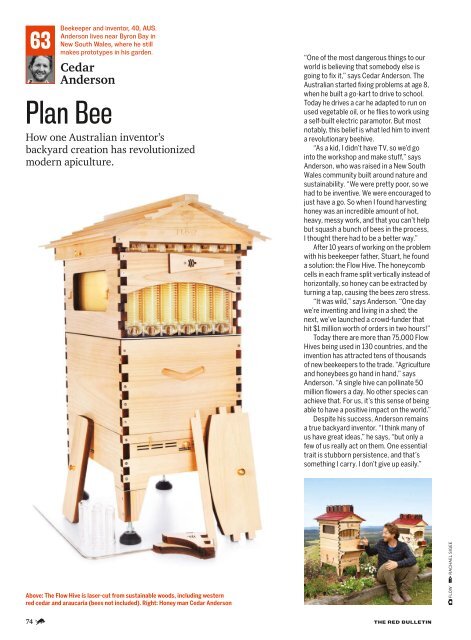Create successful ePaper yourself
Turn your PDF publications into a flip-book with our unique Google optimized e-Paper software.
63<br />
Beekeeper and inventor, 40, A<strong>US</strong>.<br />
Anderson lives near Byron Bay in<br />
New South Wales, where he still<br />
makes prototypes in his garden.<br />
Cedar<br />
Anderson<br />
Plan Bee<br />
How one Australian inventor’s<br />
backyard creation has revolutionized<br />
modern apiculture.<br />
“One of the most dangerous things to our<br />
world is believing that somebody else is<br />
going to fix it,” says Cedar Anderson. <strong>The</strong><br />
Australian started fixing problems at age 8,<br />
when he built a go-kart to drive to school.<br />
Today he drives a car he adapted to run on<br />
used vegetable oil, or he flies to work using<br />
a self-built electric paramotor. But most<br />
notably, this belief is what led him to invent<br />
a revolutionary beehive.<br />
“As a kid, I didn’t have TV, so we’d go<br />
into the workshop and make stuff,” says<br />
Anderson, who was raised in a New South<br />
Wales community built around nature and<br />
sustainability. “We were pretty poor, so we<br />
had to be inventive. We were encouraged to<br />
just have a go. So when I found harvesting<br />
honey was an incredible amount of hot,<br />
heavy, messy work, and that you can’t help<br />
but squash a bunch of bees in the process,<br />
I thought there had to be a better way.”<br />
After 10 years of working on the problem<br />
with his beekeeper father, Stuart, he found<br />
a solution: the Flow Hive. <strong>The</strong> honeycomb<br />
cells in each frame split vertically instead of<br />
horizontally, so honey can be extracted by<br />
turning a tap, causing the bees zero stress.<br />
“It was wild,” says Anderson. “One day<br />
we’re inventing and living in a shed; the<br />
next, we’ve launched a crowd-funder that<br />
hit $1 million worth of orders in two hours!”<br />
Today there are more than 75,000 Flow<br />
Hives being used in 130 countries, and the<br />
invention has attracted tens of thousands<br />
of new beekeepers to the trade. “Agriculture<br />
and honeybees go hand in hand,” says<br />
Anderson. “A single hive can pollinate 50<br />
million flowers a day. No other species can<br />
achieve that. For us, it’s this sense of being<br />
able to have a positive impact on the world.”<br />
Despite his success, Anderson remains<br />
a true backyard inventor. “I think many of<br />
us have great ideas,” he says, “but only a<br />
few of us really act on them. One essential<br />
trait is stubborn persistence, and that’s<br />
something I carry. I don’t give up easily.”<br />
Above: <strong>The</strong> Flow Hive is laser-cut from sustainable woods, including western<br />
red cedar and araucaria (bees not included). Right: Honey man Cedar Anderson<br />
FLOW RACHAEL SIGEE<br />
74 THE RED BULLETIN

















